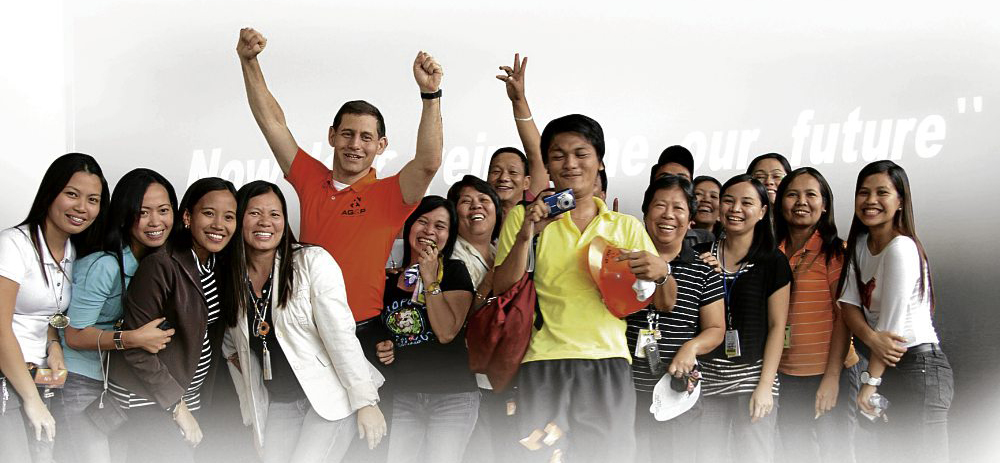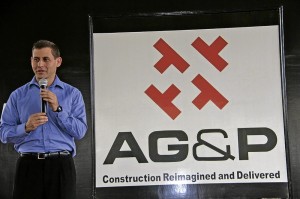American businessman Joseph Sigelman always seems to be at the right place at the right time.
After dabbling in investment banking, this Ivy Leaguer from New York built a successful business process outsourcing (BPO) enterprise in India that expanded to 42 countries.
After that, he moved on to Latin America and co-founded a thriving engineering-construction business that rode on the region’s infrastructure boom.
So perhaps it’s no coincidence that Sigelman is now putting his chips into the Philippines—and into a business where his previous experience in growing cross-border BPO and construction businesses comes in handy.
In late 2010, he organized a group that acquired Atlantic Gulf and Pacific Co. of Manila Inc. (AG&P) from the Consunji group’s DMCI Holdings.
AG&P is a 112-year-old company with a rich legacy, having built the Rizal Monument, the country’s first steel bridge and Manila’s water and sewerage system. But has been in hibernation since the Asian crisis. It was originally an American company that was acquired by industrialist Roberto Villanueva Sr. in the 1970s when Pres. Marcos instituted parity laws. DMCI took over in 1997 then sold to Sigelman.
Sigelman, the son of a doctor from New York City, graduated with honors from Princeton University’s Woodrow Wilson School of Public and International Affairs and then went to Harvard Business School.
Sigelman, who is only in his late 30s, worked with Goldman Sachs International in London at a private equity unit before becoming an entrepreneur.
It was the entrepreneur in him who saw a gem in AG&P, whose fabrication complex in Batangas is by far the largest of its kind in Southeast Asia.
“I think there’s a handful of companies that are emerging at this point in time that will carry the Filipino flag and create global brands and hopefully AG&P is one of those companies,” he says in an interview with Inquirer.
Specialization
AG&P’s specialization has evolved to what is called modularization, or building large pieces of infrastructure such as power plants or refineries piece by piece (or module), much like how one builds using Lego blocks.
The difference is that AG&P produces giant blocks out of its plant in Batangas and ships these to clients all over the world.
“The Philippines is a business process outsourcing country and I realized it’s a BPO for construction. I jokingly call it IPO or industrial process outsourcing,” Sigelman says.
The process starts with modular engineering—taking the details of design and making it more “constructible.” Based on such engineering design, AG&P starts fabricating.
“Modularization has been around for 20 years but it never really took off until recently. Even now, the preponderance of modularization has been in steel and pipe. But now you can integrate to that electrical, mechanical systems, instrumentation, heating, ventilation, airconditioning vacuums so you create these big steel blocks that are mission ready,” Sigelman says.
Once transported to client site, the modules are plugged in—just like Lego blocks.
“AG&P takes care of the engineering, fabrication, assembly, the load-out, the heavy lift, transportation, the heavy lift on the other side and we bring our people to actually set these things up, to do the installation, the operation and maintenance. It’s the entire life cycle of the project,” he says.
Such a business cuts across industries or geographies, which is why Sigelman is confident that AG&P has a huge potential for growth.
“Once it leaves our yard, it can literally go anywhere. We can modularize to be containerized,” he says.
Sigelman says that more often than not, construction projects anywhere in the world are delayed and overshoot budgets.
“I think it’s because you bring thousands of people) construction workers) together who have never met. There’s no system, no processes. And everyone knows that in 18 to 24 months, they won’t have a job, so their bonus is actually to delay the project and work a bit longer.”
Modularization, the businessman says, reduces the cost “tremendously” and delivers “better quality and a safer way of doing business.”
What AG&P sees itself doing is thus a highly disruptive approach to solving traditional construction challenges. Because the modules can essentially be plugged in and put to work, they help companies in the oil and gas, power and resource industries get in business faster and therefore start generating revenues sooner, breaking the norm of over-budgets and delays and therefore, substantially bringing down costs.
It’s a sweet spot to be in this kind of business at this point in time, Sigelman says.
“In the next five years there will be a surge in infrastructure projects in this country and we want to be a leader in that,” Sigelman says, adding that AG&P could team up with the likes of its former owner DMCI in such projects. Because AG&P does not build foundations or civil works, he says it’s not competing with local construction giants like DMCI.
Outside the Philippines, he adds that global demand for infrastructure is very high.
“The market is credible right now,” he says, noting that there are essentially more available resources than the existing infrastructure can manage and insufficient local capacity to meet that demand.
“In Latin America, there’s a shortage of workers. You have mining in Argentina, Chile, Columbia; oil and gas in Brazil, Columbia, Peru, Ecuador and Venezuela. All of these will have to be built and need a lot of workers. US may be a slowing economy but it is spending a lot on infrastructure. Canada doesn’t have enough people to do the projects being planned in Calgary and other parts of Canada. Even Africa has huge mining projects and lack of skilled labor. Saudi Arabia is changing from an exporter of crude to an exporter of refined products, so they’re building huge refineries and in all of the Gulf countries, you need power to support these,” he says.
In Australia, which has a 20-million population or one-fifth of the Philippines’, there’s $100 billion worth of contracted LNG (liquefied natural plants) today, half of which will be contracted in the next 6 to 12 months, Sigelman says.
At the same time, he says there are huge mining projects across iron ore, coal precious metals as well as huge infrastructure projects like railroads, ports, chemical plants.
A truck driver in Darwin, a city in Australia’s northern territory, makes $150,000 a year while a welder in the same city earns $250,000 a year and only works for half a year, Sigelman says.
“Everything has become so ridiculously inflated,” he says, “there are way too many projects to be supported by the local population but it has a very strict immigration policy so the only solution is modularization.”
Why in PH
If AG&P’s market is the rest of the world, is the Philippines competitive enough to be a hub for industrial process outsourcing when there are cheaper suppliers of labor and raw material in China or in other Asian countries? For Sigelman, the answer is a resounding “yes.”
“I love the Philippines and the best advantage is the work force. The Philippines has some of the best workers, best craftsmen and some of the best managers in the world. That’s an objective statement. When you go to the Gulf countries, their craftsmen of choice are always the Filipinos,” he says.
Filipinos are “incredibly productive, hardworking and highly skilled,” he adds.
Having said that, AG&P faces some constraints such as high power rates and the lack of a supply chain, for instance, steel mills. There’s less capital available compared to other markets but he says this is changing for the better.
Despite all these, he says the Filipino worker is a “very compelling proposition.”
“We’re not the cheapest when you look at this cost, but if you look at the productive hour, Philippines does extremely well,” he says.
Sigelman says that the country does not have enough access to capital compared to the likes of South Korea, which can put up big fancy fabrication yards with huge machines and highly automated processes.
If additional capital could be brought in to complement high quality Filipino workers, then the Philippines becomes a better proposition, he says.
“Remittances help (Philippine) GDP (gross domestic product) grow but you want to build companies here where people want to work. You want your best people back,” he says.
Since his group took over the company, AG&P has expanded its yard from 450,000 square meters to 1.5 million sqms. It also co-owns the Batangas International Port. While transportation is an important cost, it’s not its biggest cost, especially as cargo pricing in global shipping industry is favorable for AG&P right now.
Integrated systems
At present, AG&P can produce 60,000 metric tons of processed steel a year which should go up to 100,000 MT a year in the next few months, Sigelman says.
“But ultimately, as we think about integrated modules, it’s more than steels and pipes… integrate electrical systems and processes inside. Your yard size doesn’t need to increase but the value goes up,” he says.
AG&P did not have much of a commercial business but since Sigelman came in full time in May of last year, the company has bagged nearly $350 million in contracted sales. This is expected to increase “very significantly” this year and grow to several hundreds of millions of dollars in backlog sales by the end of this year.
Apart from increasing the yard’s footprint in Batangas, he expanded the management team, built systems and improved cost structure.
Sigelman estimates that AG&P will invest $200 million to $250 million over the next 12 to 18 months into the business. By end of this year, it expects to employ 3,500 people in its yard which by the middle of next year, grow to several thousands, many of whom will be women.
“We’re focused on diversity. I’d like to have 50 percent of our welders to be female,” Sigelman says, noting it’s not true that welding is an occupation for men. “You don’t have to lift anything. It’s doing it with a very steady hand,” he says. AG&P’s best welder in a recent project for British Petroleum, he says, is a lady who was given a citation by BP itself.
“We’re giving people in Batangas an opportunity to work in a safe environment where they have a long term career. It’s a lot better option than going to work in Saudi Arabia,” he says, adding this in turn will also help earn foreign exchange for the country even without having to export workers.
Apart from Sigelman, AG&P’s investor group includes local groups and a Kuwaiti fund. The company, which was brought back to private hands after the group’s purchase from DMCI, is majority Filipino-owned.
“We’re investing here. We’ll continue to invest here. This is our home,” says Sigelman.



